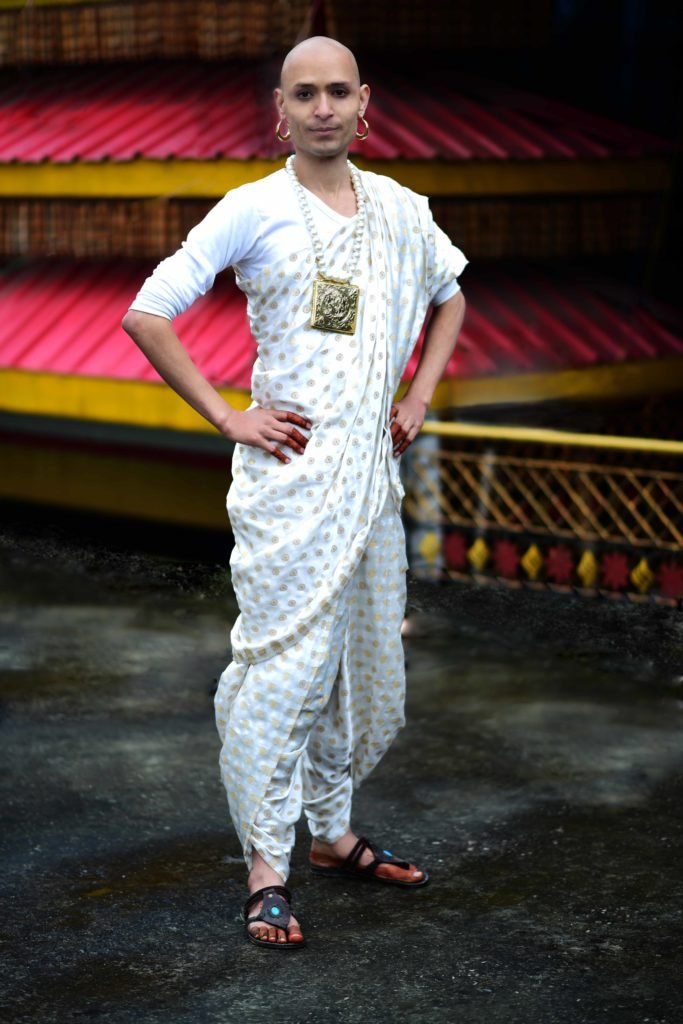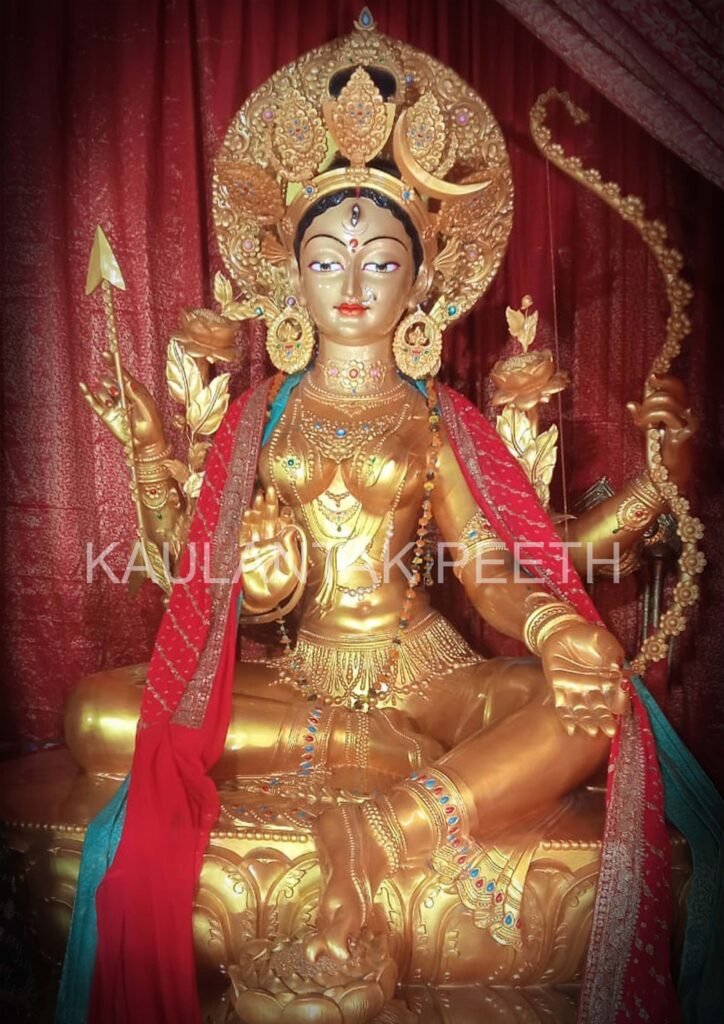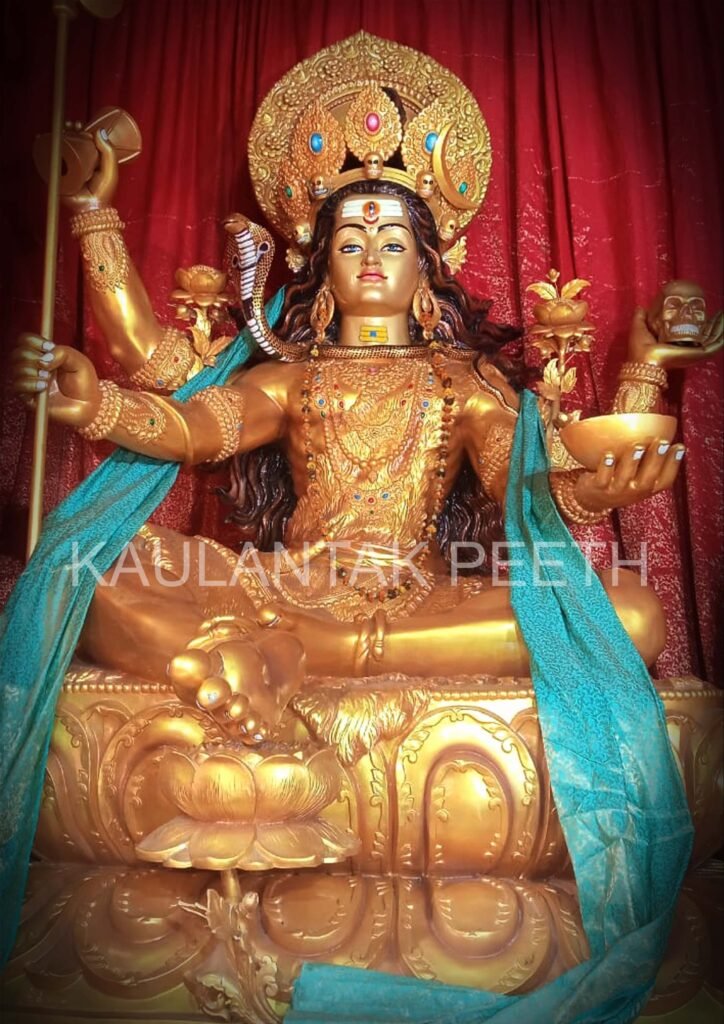Kula Devta is also known as the traditional ‘family deity or lineage deity’ that has been carried out from generations to generations through a family or lineage system. The worship of Kula Devta denotes the worship of both male deity and female deity. A big festival of Kula Devta worship is done on periodic basis or in small scale daily basis. ‘Kula Devta’ is the symbol of unity among the clans.
As per Siddha Dharma, ‘Kula Devta’ is also a symbolic representation, emblem, totem etc which has been passed down from hereditary or through guru/disciple lineage system.
Etymology
Kula Devta, etymologically is made up of two words (Kula + Devta), where Kula denotes family and Devta means gods/goddess. Therefore, Kula Devta is known as family deity. The word ‘Kula’ doesn’t only mean family in a pure sense, it also means family lineage. Kula is the collective word for the origin of the family to the present day family system. For instance, a Rajput’s ‘Kula Devta’ is always same from primitive times till today’s day and age. As it passes through family blood lineage system, it continues in an unbroken succession.
Furthermore in Tantra, ‘Kula’ means more of a ‘lineage’ then family because family denotes blood relationship but in tantra, it is lineage system because blood relationship is not involved. A disciple goes to the Guru and the Guru initiates the disciples into his or their own respective Tantra Kula. Tantra is the system of ‘Kula’ because each Kula has their respective mantra, yantra, worship module, philosophies and the Guru passes these ‘Kula’ knowledge’s to the disciple and the disciple in return passes it to their respective disciples ensuring the ‘Kula’ always expands. The Kaulantak Peeth tradition collectively is ‘Kali Kula’ i.e it worships Mahakali as it Kula Devta. But within it, there are different variations. The ‘Kaula Kula’ that His Holiness Kaulantak Peethadhiswara Mahayogi Satyendra Nath Ji Maharaj (Ishaputra) belongs to is the ‘Kula’ of goddess ‘Kurukulla’. Since, Kurukulla is a rajasic goddess; therefore the ‘Kaula Kula’ is rajasic in nature.As per the Siddha tradition, ‘Kula Devi’ and ‘Kula Devta’ of Kaula Siddhas are ‘Kurukulla’ and ‘Swachhanda Bhairava.
Classifications of ‘Kula Devi/Devta’
‘Kula Devta’ is the symbolic manifestation of ‘family deity’. The Siddha Dharma believes that since ‘Kula Devta’ is a totem or pratik, it can be both, living and non living entity. Different cultures and different civilizations have their own system of ‘Kula Devta’. The ‘Siddha Dharma’ calls “Kula Devi” and “Kula Devta” as Kuleshwari and Kuleshwara respectively.
Furthermore, the ‘Kuleshwara and Kuleshwari’ tradition of the ‘Siddha Dharma’ can basically be explained through some classifications. They can be classified based on four categories. As per ‘Siddha Dharma’, all the ‘Kuleshwara and Kuleshwari’ fall into these four categories. They are believed to be the manifestation of one of these forms. These four categories represent both theist and atheist school of ‘Kula Devi/Devta’.
Shiva/Shakti Swaroop:
As per ‘Siddha Dharma’ which itself is a shaiv and shakta lineage believes that the foremost form of Kuleshwara and Kuleshwari are the forms of Shiva/Shakti. Every tantra kula including the ‘Kaula Siddha’ has its own Kuleshwara and Kuleshwari. For instance, The Kuleshwara and Kuleshwari of ‘Siddha Dharma’ are Swachhanda Bhairava and Ma Kurukulla respectively. Not only the gods but the ‘Siddha Dharma’ even has ‘Kula Devta’ in the forms of animals, trees, mountains etc. They are also considered as the manifestation of Shiva/Shakti. For instance, the indigenous people of Himalaya region of Mustang, Manang of Nepal treat special form of Yak as their ‘Kula Devta’. Yak is believed to be the symbolic manifestation of Lord Shiva. Similarly, some shaman traditions of Tibet and Nepal treat Kailasha as their ‘Kula Devta’ which is also the symbolic manifestation of lord Shiva. Every Kuleshwara and Kuleshwari of ‘tantra kula’ is the manifestation of the form of Shiva/Shakti and it is also believed to be the supreme form.
Vishnu/Lakshmi Swaroop:
As per ‘Siddha Dharma’, many ‘Kula Devi/Devta’ can also be classified as the manifestation of Vishnu/Lakshmi. Mostly, the ‘Kula Devi/Devta’ of Vishnu/Lakshmi form is rajasic in nature because Lord Vishnu is the epitome of rajas nature. For instance, Lord Jagganath is the form of Vishnu and it is the ‘Kula Devi/Devta’ of many people of Odisha, India.
Even the ‘Kula Devi/Devta’ in the forms of animals and plants are treated as the manifestation of the form of Vishnu/Lakshmi. People who worship ‘Tulsi’ as ‘Kula Devi/Devta’, is worshipping the Vishnu/Lakshmi form. The ‘Siddha Dharma’ also believes ‘shaligram’ stone as the manifestation of the form of Vishnu/Lakshmi. Many community in the Hilly regions of Nepal and especially the Vaishnava Brahmin’s sect worship ‘shaligram’ stone as their ‘Kula Devi/Devta’.
Brahma/Saraswati Swaroopa
As per the ‘Siddha tradition’, most of all the satwik ‘Kula Devi/Devta’ is closely related to the forms of Brahma/Saraswati. Brahma is the adi purusha who was cursed by lord Shiva that his worship would be forbidden. Therefore, the ‘Kula Devi/Devta’ worship of Brahma is not known, instead Gayatri worship is related to Lord Brahma. Gayatri worship is the alternative form of worship of Lord Brahma. Any individual or community who’s ‘Kula Devi/Devta’ is Gayatri, they worship Gayatri as the manifestation of Brahma/Saraswati form. Furthermore, as per ‘Siddha Dharma’ even non flowers can be the form of ‘Kula Devi/Devta’. In Himachal Pradesh, there are some community who worship the yellow flowers that is exclusively only found in Hans Kund area inside the great Himalayan National park. The flowers are brought down to the community and worshipped it as ‘Kula Devi/Devta
Prateek Brahma Swaroop:
Prateek means symbol, emblem, totem etc that represents ‘Kula Devi/Devta’. As per ‘Siddha Dharma’, even symbols, emblem, totem is worshipped as ‘Kula Devi/Devta’. The ‘Shaligram’,’Tulsi’, ‘Mount Kailash’, ‘flowers’ that has been discussed above are the symbolic representation of the absolute. As per ‘Siddha Dharma’, the formless has no form so it is impossible to worship formless without any symbol, emblem or any kind of representation. This is where the idea of totem or symbol comes to play. For instance, In Himachal Pradesh, there is a temple of goddess Totala but to the great amazement, not an idol but a round black stone is worshipped. The black stone is the representation of Brahmanda linga. Similarly, the Kirats of Nepal who practice Mundhum, also worship an egg as their “Kula Devi/Devta’ which is the representation of Hiranyagarbha and this whole universe.
‘Kula Devta’ as totem and Pratikopasana
The ‘Siddha Dharma’ also considers ‘Kula Devta’ as a totem. A totem can be both, living or non living entity. Totem is universally practiced by shamans and Pagan religion. Totem is something symbolic, emblem or representation in tangible or intangible form. Totem is also a symbol of unity, just like a flag of a country is the symbol of patriotism for all.
As Sigmund Freud in his book “Totem and Taboo” mentions that totem is something that every family has. It is something passed down heredity from the parents to the children. So, people with same totem cannot marry because it denotes incest but ‘Siddha Dharma’ has its own beliefs. The totem as per Freud is something that denotes family members and same totem means same family members but we differ in aspect that we do not allow marriage to take part in the same ‘gotra’ and it is thought as incest but the ‘Kula Devta’ of two different gotras can be one so two person with different gotra with the same ‘Kula Devta’ can be married and there is no incest.
As per ‘Siddha Dharma’, ‘Kuleshwara’ and ‘Kuleshwari’ are the epitome of unity among the clans. It is something that holds them together. They have their own philosophy towards their life, so ‘Kuleshwara’ and ‘Kuleshwari’ are the epitome of their own thought process. So, the clan who believes in being brave, warrior like and yearn for salvation, they have their ‘Kula Devi/Devta’ as a warrior god or goddess. That inner trait of them is given in the form of ‘Kula Devta/Devi’. So as per ‘Siddha Dharma’ the pictures or the temple is nothing but pratikopasana i.e symbolic worship. So, the debate between direct worship and idol worship does not make sense because one worships directly and the other uses medium to worship. Rationale of ‘Kula Devi/Devta’ worship
As per ‘Siddha Dharma’, the worship of Kuleshwara and Kuleshwari is utmost important for any person for their own development and salvation. It is the source of power for the people. Just like a flag gives power to the soldier to give up their life for their country, similarly ‘Kuleshwara’ and ‘Kuleshwari’ gives the power to the individuals of the clan to strive for perfection in whatever they do. Firstly, they give you courage to face the world and secondly to strive for Moksha.
The rationale of ‘Kula Devi/Devta’ worship can be explained through the movie ‘Inception’. The protagonist of the film has a totem with him and the totem is the ‘spinning top’. Since, the movie is about reality and dreams, the protagonist uses the totem to infer if he is awake or in dreams and also if the circumstances are real or if it’s just a dream. When he spins the top and it doesn’t stop then he is dreams, but if spins and it stops then than he is awake and it’s real. Similarly, ‘Kula Devta/Devi’ is like a totem. They help an individual of the clan to infer and differentiate between reality and maya. According to ‘Siddha Dharma’, both Maya and Brahman are real. Maya is real because it is inseparable from Brahman. It is similar to the concept of Prakriti and Purusha of ‘Mahasiddha Kapil muni’ and Shiva and Shakti of our own lineage. Everything that we see in this world is Shakti or Maya but the nucleus of everything in this universe is Shiva. Shakti only revolves around Shiva. Shiva and Shakti are same and there is no difference between them. It is just like brave and bravery. A person is brave but when he puts his courage into action that becomes bravery. So brave and bravery are one single act of the same entity.
The visible part of this universe is Shakti and Shakti is always evolving but the Shiva always remains constant. So, this physical universe or matter is always changing so Maya is false in the sense that it is always evolving and not constant. So, ‘Kula Devta/Devi’ is like a totem that acts as an indicator for a person to walk in the path of salvation. The constant worship of ‘Kula Devta/Devi’ acts like a totem for the individuals to separate the physical world with the inner world and pursue the original path of salvation. As per ‘Siddha Dharma’, the rationale of ‘Kula Devta/Devi’ is to refocus ones aim from materialism to the path of salvation.
Origin of ‘Kula Devta’ worship:
The origin of the word ‘Kula’ as per ‘Siddha Dharma’ is attributed to goddess ‘Kurukulla’. Just like the world ‘Kaulantak’ emerged from ‘Kulantara’, ‘Kulluta’ etc similarly ‘Kula’ originated from the word ‘Kulla’. The ‘Siddha Dharma’ is a ‘Shaiv and Shakta Kula’. So, the Kula Devta of ‘Siddha Dharma’ primarily is considered to be Shiva and Shakti. The ‘Siddha Dharma’ believes that ‘Kula Devta’ for the house holders was formed by the consent of the deity with the ancestors of the lineage in the primitive era. They believe that at ‘Satya Yuga’ when it was agrarian society, the gods who were highly elevated manifested before our ancestors. The gods who were compassionate at their core wanted to help our ancestors. So, the compassionate god who manifested asked the individuals to ask for a boon. The gullible people not infested by ‘kali’ had no material wishes so they made no wishes for the boon. But to not defy the gods, they finally made the wish that the future of their family lineage or ‘Kula’ should always be protected by the deity and it should always expand. The gods then gave them the boon and through consent of the gods and our ancestors, the ‘Kula Devta’ started to incur obligations and then they started to protect the family or ‘Kula’ of the individuals. The ‘Kula Devta’ always protects the ‘Kula’ based on the promise made by them to the ancestors of that particular ‘Kula’. Since, they are bound by promise they always look after the ‘Kula’ despite today’s generation not worshipping them.
Benefits of Kula Devta worship
‘Kula Devta’ worship is the most beneficial karma for any householders. An individual is always protected by ‘Kula Devta’. The powers of ‘Kula Devta’ protect the individual where ever they go, pacify all the grievances and repel all miseries. They also ensure that the lineage is never stopped. So, they especially take care of the children and protect them for any harm and accidents.
The ‘Siddha Dharma’ prescribes intensive worship of ‘Kuleshwara and Kuleshwari’ such that they should be remembered before starting any auspicious activity. Any individual can only prosper in the path of spiritualism if their ‘Kula Devta’ blesses them. Without ‘Kula Devta’ even moksha is unattainable.
Furthermore, the ‘Siddha Dharma’ believes that ‘Kuleshwara and Kuleshwari’ is a cheat code to be reborn as humans in the next birth. Only humans have the capacity to worship ‘Kula Devta’ so an ardent ‘Kula Devta’ worshipper always takes the human birth. The ‘Kula Devta’ also ensures that in the next birth, the individual is born in the particular family or lineage where the particular ‘Kula Devta’ is worshipped. They do it out of seer love but their love is not visible. They hide behind the curtains and orchestrate the play of the individual’s life.
History of Kula devta worship.
The ‘Kula Devta’ worship is explicitly mentioned in the scriptures. The scripture says that the ‘Kula Devta’ was worshipped before going to the wars or taking any personal initiative to perform big tasks.
In Ramayana, ‘Nikumbala Devi’ is mentioned to be the ‘Kula Devi’ of the Pulastya lineage. Maharishi Pulastya was the grandfather of Ravana and father of Maharishi Visharva. Indrajeet, the son of Ravana had specially performed some tantric worship to please his ‘Kula Devi’ to defeat lord Rama and Lakshmana.
In the case of Nepal, Mahasiddha Guru Gorakshnath is considered to be the ‘Kula Guru’ of the ex-kings of Nepal. The legend says that Mahasiddha Gorakshnath appeared before the great king Prithvi Narayan Shah of Gorkha and bestowed him the boon to be a great unifier. The ‘Kula Devi’ of the ex-kings of Nepal is ‘Gorakh Kali’ which still exists near Gorkha place in Nepal. Every year the ex-kings family worships and send offerings to the deity at Gorkha. The ‘Kula Devta’ of the whole country Nepal is ‘Pashupati Nath’ who is lord Shiva himself.
The ‘Kula Devta’ of Siddha Dharma:
The ‘Siddha Dharma’ is the lineage of the Siddhas and it is exclusively a Shaiv Kula. The primary ‘Kula Devta’ of ‘Siddha Dharma’ is lord Shiva as he is also considered as the first ‘Kula Devta’ of civilization. ‘Ma Kurukulla’ is the ‘Kula Devta’ of the ‘Kaula Kula’ because ‘Kaula’ are ‘Siddhas’. But in contemporary age, the ‘Kula Devta’ of ‘Siddha Dharma’ based on the teachings of His Holiness Kaulantak Peethadhiswara Mahayogi Satyendra Nath Ji Maharaj (Ishaputra) from guru-disciple lineage is ‘Siddha Siddhanta Nath Ji Maharaj”. He is also the guru of Mahasiddha Ishaputra. He is just not only a guru but also ‘Kula Guru’ of ‘Siddha Dharma’. The whole initiative taken by His Holiness to reinstate the glory of Hinduism can be attributed to him. Without his compassion, ‘Siddha Dharma’ could have never been formed.
The Kuleshwara and Kuleshwari of ‘Siddha Dharma’ are Swachhanda Bhairava and Ma Kurukulla respectively. Since, ‘Siddha Dharma’ is a rajasic tradition so it has rajasic Kuleshwara and Kuleshwari.
Furthermore, the ‘Siddha Dharma’ also has gupta (unrevealed) ‘Kuleshwara and Kuleshwari’. They are ‘Brahmanda linga and Brahmanda yoni’ respectively. They are formless in nature and since they are unrevealed to the general public, one should learn it from their guru.
Yantra of ‘Kuleshwara and Kuleshwari’
The ‘Kuleshwara and Kuleshwari’ as per ‘Siddha Dharma’ is worshipped through yantra. Yantra is the ‘pratikopasana’ or symbolic representation of the deity in the form of geometric figures. So, ‘Kuleshwara and Kuleshwari’ can be worshiped through yantra.
The yantra of ‘Kuleshwara and Kuleshwari’ consists of Bindu, trikona i.e triangle, vritta i.e circles and bhupura or the gateway of the yantra. As per ‘Siddha Dharma’, the yantra of ‘Kuleshwara and Kuleshwari’ is amalgamated to form a single yantra. The yantra represents both male and female deity.
The yantra is secretive and is only given to the respective clans or who are initiated into the worship of ‘Kuleshwara and Kuleshwari’. One should obtain the yantra through a worthy guru.
Mantra of ‘Kuleshwara and Kuleshwari’
The mantra of Kuleshwara and Kuleshwari are given by the guru to the disciples. As per ‘Siddha Dharma’, the guru always explains his disciples the nature of the mantra, its usage and to which lineage it belongs. Therefore, it is utmost important to receive the mantra from the worthy guru to know its variations, usages and basically all the mantras have been locked by Lord Shiva so to stop its misuse. There guru unlocks the mantra and bestows it to the disciples.





